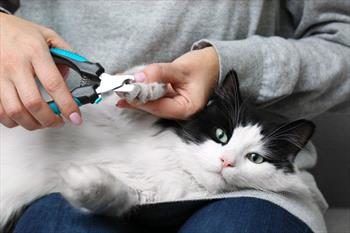Sarah Nugen, Class of 2023; Sandra Robbins BS, CVT, VTS (Anesthesia & Analgesia), CPDT-KSA, KPA-CTP; Katharine Schwarz, RVT, KPA CTP
Cat nail trim in lap

Photo courtesy of Depositphotos
How to help your cat get used to having their nails trimmed
- Start by putting the trimmers in a common area like your living room where your cat can choose to explore them at their pace. Putting treats around the nail trimmers can help to create more positive associations with them. If your cat will not go near the trimmers, feed them treats at a comfortable distance. Gradually decrease the distance between them and the nail trimmers.
- Next, have the nail trimmers nearby when you are interacting with your cat. This interaction may be a play session or a time when your cat is comfortably settled on your lap accepting treats. You do not need to move the nail trimmers around, just have them within view of your cat when they are near you.
- Let your cat see you lift and put down the nail trimmers. If your cat enjoys lying on your lap, you can have the nail trimmers near, pick them up and put them down, then feed your cat a treat.
- Practice bringing the nail trimmers to your cat’s foot, then moving them away and giving your cat a treat. If your cat is too stressed about this step, only bring the nail trimmers part way to your cat’s foot before putting them back down and giving a treat.
- After your cat has learned to tolerate a single nail being isolated and examined with the trimmers nearby, cut the toenail. Then begin adding toes to individual sessions until you can cut multiple toenails in one session.
Overall, you want your cat to feel as comfortable, safe, and relaxed as possible when getting their nails trimmed. Work with your veterinarian and staff to make nail trims at home and at the clinic the most positive experience possible for your cat.